Last Updated on 4 months by Francis
Thermal imaging cameras have become increasingly popular for capturing real-time thermal images of various objects. These cameras are capable of penetrating materials like plastic, smoke, dust, and fog to capture thermal radiation. However, certain materials can block or stop the passage of infrared light. One such material is aluminum foil.
Aluminum foil acts as a barrier and does not allow infrared radiation to pass through it effectively, making it ineffective for blocking infrared. Despite reflecting some of the infrared rays, it prevents the majority of the infrared radiation from passing through.
Contents
Key Takeaways:
- Aluminum foil is not effective for blocking infrared radiation.
- It acts as a barrier and prevents the majority of the infrared radiation from passing through.
- Thermal imaging cameras can see through materials like plastic, smoke, dust, sand, rain, fog, and darkness, but not aluminum foil.
- Materials like walls, concrete, glass, metal, water, and aluminum foil block or reflect infrared rays, making them invisible to thermal imaging cameras.
- When considering the application of thermal imaging, it’s important to understand its limitations and capabilities.
What Can Thermal Imaging See Through?
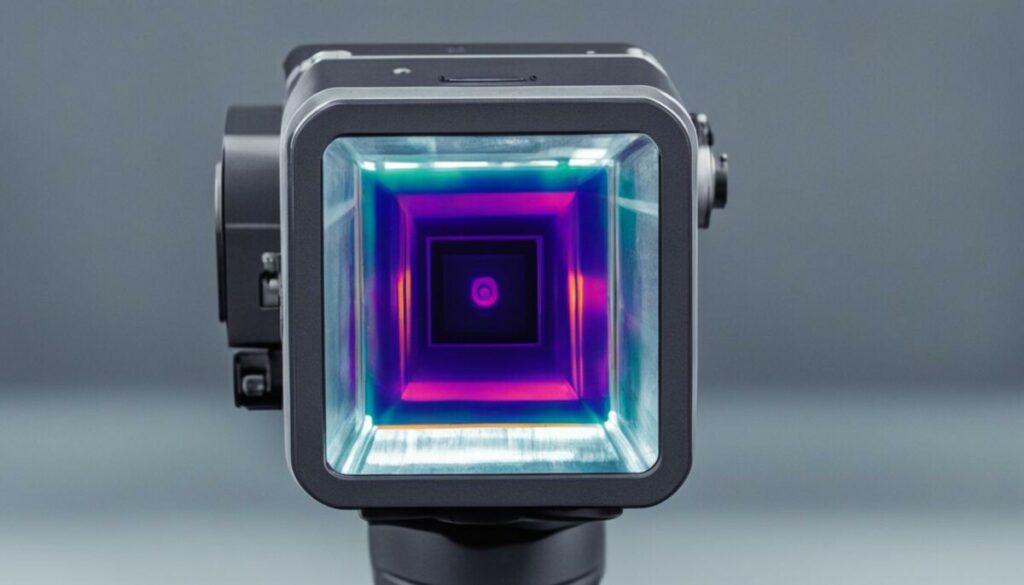
Thermal imaging cameras have the ability to see through certain materials that allow the passage of infrared light. These materials do not block or stop infrared rays, enabling thermal imaging cameras to capture the thermal radiation emitted by objects. Some of the materials that thermal imaging can see through include:
- Plastic
- Smoke
- Dust
- Sand
- Rain
- Fog
- Darkness
Thermal imaging cameras use the infrared radiation emitted by objects to create visual representations of their heat signatures. By detecting the thermal radiation passing through these transparent materials, thermal imaging cameras provide valuable insights and information about temperature variations and patterns.
On the other hand, certain materials act as barriers to infrared radiation, making them opaque or reflective to thermal imaging. These materials block or reflect the infrared rays, preventing them from reaching the camera’s sensor. Some examples of materials that block thermal imaging include:
- Walls
- Concrete
- Glass
- Metal
- Water
- Aluminum foil
Transparent and Opaque Materials for Thermal Imaging
Transparent materials such as plastic, which allows the passage of infrared light, are ideal for thermal imaging. They enable the camera to capture and detect the thermal radiation emitted by objects. These materials act as windows through which the infrared rays can pass, providing valuable thermal data.
On the other hand, opaque materials like walls, concrete, glass, metal, water, and aluminum foil block or reflect infrared radiation, making them invisible or less detectable to thermal imaging cameras. These materials limit the camera’s ability to capture thermal information from objects or surfaces behind them.
Example Table: Comparing Transparent and Opaque Materials for Thermal Imaging
| Transparent Materials | Opaque Materials |
|---|---|
| Plastic | Walls |
| Smoke | Concrete |
| Dust | Glass |
| Sand | Metal |
| Rain | Water |
| Fog | Aluminum foil |
| Darkness |
Note: The above table showcases examples of transparent and opaque materials for thermal imaging and is not an exhaustive list.
How Do Thermal Imaging Cameras Work?
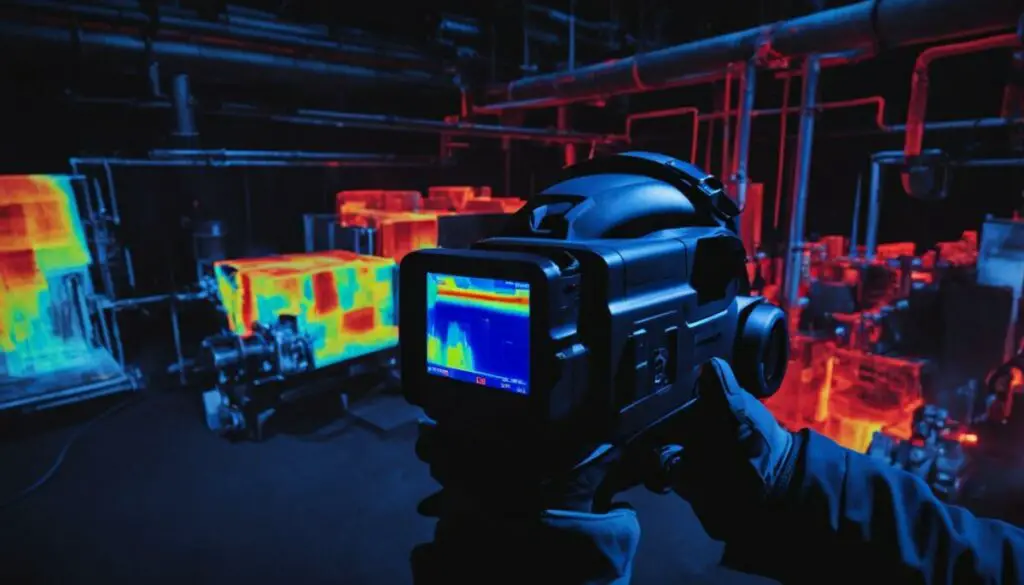
Thermal imaging cameras are remarkable devices that can capture and visualize the thermal energy emitted by objects. They work by utilizing the principles of infrared radiation detection to create detailed thermal images.
These cameras are equipped with special sensors that can detect infrared radiation, which is essentially the thermal energy that objects emit. When an object emits infrared radiation, the thermal imaging camera captures it and converts it into an electronic signal.
This conversion of thermal energy into an electronic signal is achieved through the use of a detector within the camera. The detector can differentiate between different levels of infrared radiation based on temperature variations.
Once the thermal energy is converted into an electronic signal, the camera processes the data and displays it as a thermal image on a monitor. This image represents the distribution of temperatures across the scene captured by the camera.
Thermal imaging cameras possess the remarkable ability to detect even subtle temperature differences, enabling them to create detailed images. These images can be displayed in grayscale or with color overlays, where different colors represent different temperature ranges.
By visualizing the thermal changes and anomalies present in the captured scene, thermal imaging cameras find application in various industries, including firefighting, industrial inspections, electrical troubleshooting, and even medical diagnostics.
| Advantages of Thermal Imaging Cameras | Disadvantages of Thermal Imaging Cameras |
|---|---|
|
|
What Materials Can Infrared Pass Through?
Infrared radiation is capable of passing through a variety of materials, including:
- Air
- Plastic (depending on thickness)
- Smoke
- Dust
- Sand
- Rain
- Fog
- Darkness
These materials allow infrared waves to penetrate and can be easily detected by thermal imaging cameras. However, there are certain materials that block or reflect infrared rays, making them opaque for thermal imaging. These materials include:
- Walls
- Concrete
- Glass
- Metal
- Water
- Aluminum foil
It is important to note that while materials like aluminum foil can block or reflect infrared radiation, they may not provide complete protection against it. Therefore, if infrared blocking is required, it is advisable to use materials specially designed for such purposes.
Can Thermal Imaging See Through Aluminum?
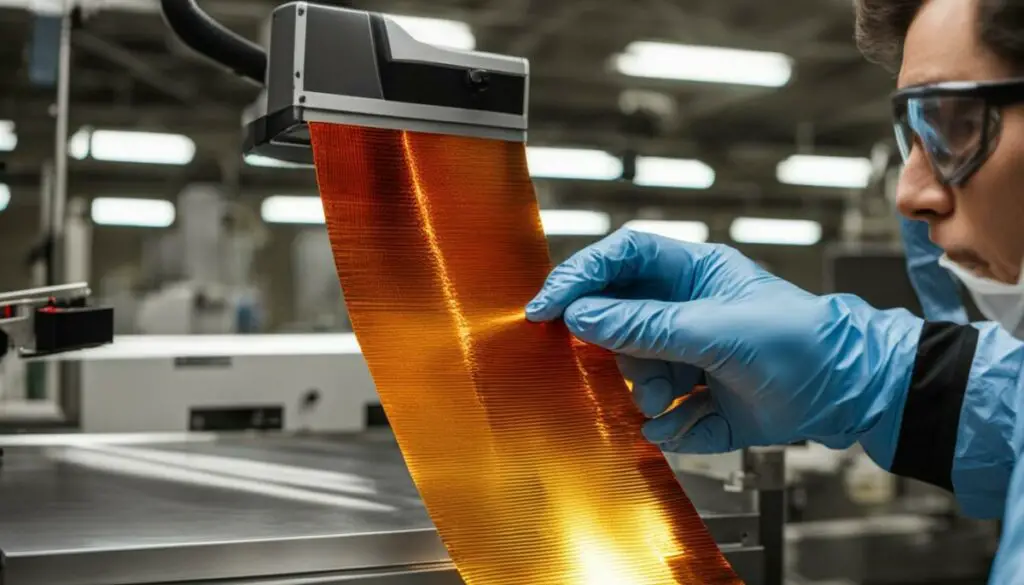
Thermal imaging technology has revolutionized various industries, allowing us to visualize and analyze thermal energy emitted by objects. However, when it comes to aluminum, thermal imaging faces limitations.
Aluminum is a metal that reflects heat and does not transmit it effectively. This property makes it challenging for thermal imaging cameras to see through aluminum. While these cameras can capture some of the infrared energy reflected off the surface of aluminum, they cannot detect objects or temperature changes concealed behind it.
The reflective nature of aluminum restricts the penetration of infrared rays. Thermal imaging cameras rely on the ability of materials to transmit infrared light in order to form images based on the differences in temperature. Since aluminum does not transmit heat well, it hampers the thermal imaging process when trying to see through it.
However, this limitation of thermal imaging with respect to aluminum is not a drawback, as the technology has proven effective in numerous other applications. Thermography can still detect surface temperatures and thermal anomalies on the aluminum itself, providing valuable insights.
To summarize, thermal imaging cannot see through aluminum due to its reflective and heat-resistant properties. While aluminum foil may be effective in blocking infrared radiation, it also obstructs the ability of thermal imaging cameras to visualize objects or temperature changes beyond the foil.
How to Block Infrared Rays?
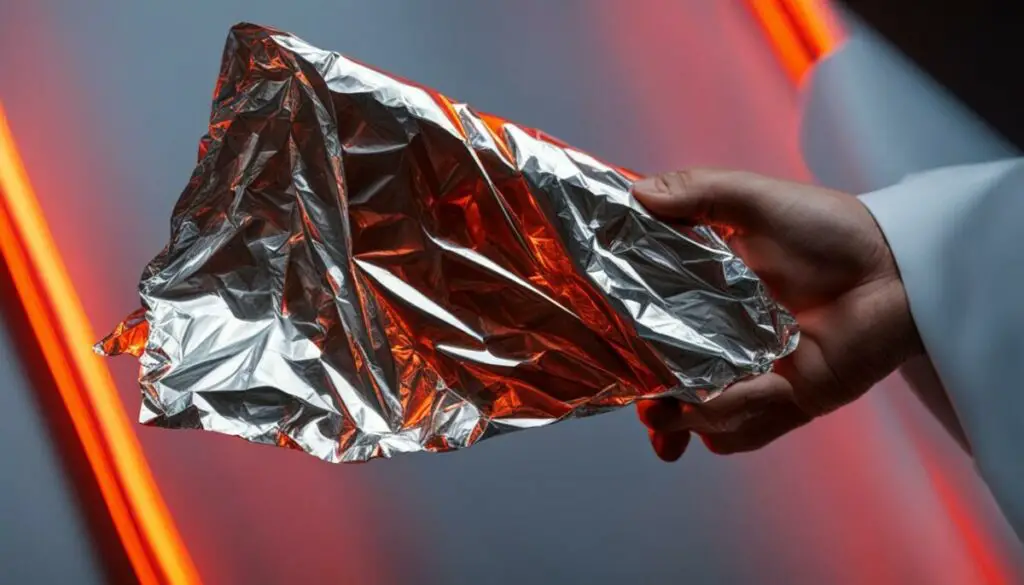
Infrared rays can be effectively blocked or reduced by employing various methods and materials. Whether you are concerned about thermal insulation, reflective barriers, or window coverings, there are several solutions available to prevent the passage of infrared radiation.
One common approach is to utilize materials that possess a high degree of reflectivity or absorption of infrared light. For instance, aluminum foil, metalized plastic film, or specially designed multi-layer films can act as effective barriers. These materials reflect or absorb a significant portion of the incoming infrared radiation, thereby reducing its transmission.
Window coverings or glass with infrared reflective or absorbing coatings can also play a crucial role in limiting the amount of infrared radiation that enters a space. These treatments help create a thermal barrier, preventing excessive heat transfer.
Furthermore, thermal insulation materials like fiberglass or foam can be used to minimize the transfer of infrared heat through walls. By enhancing the insulation properties of a structure, these materials provide an additional layer of defense against the penetration of infrared rays.
Here is a summarized list of materials and methods for blocking infrared rays:
- Aluminum foil
- Metalized plastic film
- Multi-layer films
- Window coverings with infrared reflective or absorbing coatings
- Thermal insulation materials such as fiberglass or foam
By employing these strategies, you can effectively prevent the transmission of infrared radiation and regulate the thermal conditions of your space. Whether it’s for energy efficiency, privacy, or comfort, blocking infrared rays can be a valuable tool in maintaining a controlled and comfortable environment.
Can You Hide from Thermal Imaging?
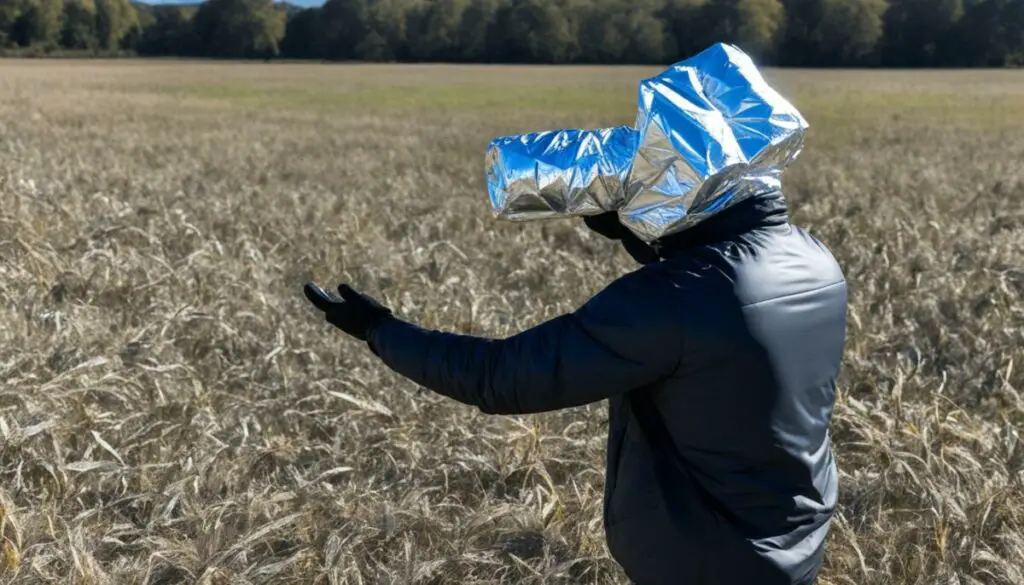
When it comes to evading thermal imaging, there are various methods and materials that can help you stay hidden. Whether you’re trying to avoid detection or maintain your privacy, understanding how to hide from thermal cameras can be invaluable.
Thermal Camouflage
One effective approach to hide from thermal imaging is by using camouflage fabrics or draping materials. These fabrics are designed to absorb thermal radiation, making it difficult for thermal cameras to detect your presence. By blending in with your surroundings, you can become less visible to thermal detection.
Specialized Clothing and Fabrics
Another way to hide from thermal imaging is through specialized clothing and fabrics that reflect or refract thermal radiation. These innovative materials can manipulate the way thermal energy is emitted, making the wearer virtually invisible to thermal cameras. By wearing such clothing, you can effectively shield yourself from thermal detection.
Natural Elements
Utilizing natural elements like trees and shrubs can also aid in hiding from thermal imaging. These elements reflect or absorb infrared radiation, making it harder for thermal cameras to detect your presence. By positioning yourself strategically among foliage or other natural features, you can obscure yourself and remain undetected by thermal cameras.
Physical Features and Elevation
Additionally, using physical features and elevation can help you evade thermal imaging. By positioning yourself behind solid objects, such as walls or structures, you can block the thermal radiation emitted by your body. Changes in elevation can also help obscure yourself from thermal cameras, as these devices may have difficulty capturing thermal signatures from higher or lower vantage points.
By combining these methods and considering your surroundings, you can significantly increase your chances of remaining hidden from thermal imaging.
| Methods | Description |
|---|---|
| Thermal Camouflage | Using camouflage fabrics or draping materials that absorb thermal radiation. |
| Specialized Clothing and Fabrics | Wearing clothing and fabrics that reflect or refract thermal radiation, rendering the wearer invisible to thermal cameras. |
| Natural Elements | Utilizing trees, shrubs, or other natural features that reflect or absorb infrared radiation. |
| Physical Features and Elevation | Using solid objects or changes in elevation to block or obscure thermal radiation. |
How to Stop Thermal Radiation?
Thermal radiation can be effectively controlled and minimized through various methods, including thermal insulation, the use of reflective barriers, shading windows, and preventing heat transfer. Implementing these strategies can help create a more comfortable and energy-efficient environment. Let’s explore each method in detail.
Thermal Insulation
Insulation materials such as foam, fiberglass, or cellulose are excellent choices for slowing down heat transfer between spaces and reducing the amount of thermal radiation that passes through walls. These materials have low thermal conductivity, which means they limit the transfer of heat, effectively blocking thermal radiation from entering or exiting a space.
Reflective Barriers
Using reflective barriers can significantly reduce the impact of thermal radiation. Aluminum foil or heat-resistant films can be placed between surfaces or integrated into building structures. These barriers reflect or block thermal radiation, preventing it from penetrating through walls, roofs, or other surfaces.
Shading Windows
Windows are a common entry point for thermal radiation. Adding shading devices such as blinds, curtains, or window films can help reduce the effect of thermal radiation entering a space. These shading solutions can be designed to block or reflect infrared rays, minimizing heat transfer and improving thermal comfort indoors.
Preventing Heat Transfer
Preventing heat transfer is crucial in minimizing thermal radiation. By using materials with low thermal conductivity, such as insulation, or by creating air gaps between surfaces, the transfer of heat can be significantly reduced. This approach prevents thermal radiation from flowing freely and helps maintain a more consistent temperature within a space.
By implementing a combination of these methods, it is possible to effectively stop or reduce thermal radiation, creating a more energy-efficient and comfortable environment.
| Method | Description |
|---|---|
| Thermal Insulation | Using insulation materials such as foam, fiberglass, or cellulose to slow down heat transfer and limit thermal radiation. |
| Reflective Barriers | Adding aluminum foil or heat-resistant films to reflect or block thermal radiation from surfaces. |
| Shading Windows | Using blinds, curtains, or window films to reduce the impact of thermal radiation entering through windows. |
| Preventing Heat Transfer | Creating air gaps or using materials with low thermal conductivity to minimize the transfer of heat. |
What Blocks Infrared Vision?
Infrared vision, achieved through thermal imaging cameras, can be blocked by various factors. These include atmospheric interference, reflective surfaces, dense foliage, and solid objects. Let’s explore each of these factors in detail:
Atmospheric Interference
The atmosphere itself can absorb, reflect, or scatter infrared radiation, which can interfere with infrared vision. This interference can affect the clarity and accuracy of thermal images captured by thermal imaging cameras.
Reflective Surfaces
Reflective surfaces like mirrors can block the camera’s line of sight and prevent it from detecting infrared radiation. The reflective nature of these surfaces bounces off the infrared rays, leading to a lack of visibility in thermal imaging.
Dense Foliage
Dense foliage, such as trees and plants, can block infrared radiation, making it difficult to see objects behind them. The leaves and branches of these plants absorb and scatter the infrared rays, causing obstructions in thermal imaging.
Solid Objects
Solid objects, such as walls or roofs, act as barriers for infrared radiation. They block the passage of infrared rays, preventing thermal imaging cameras from capturing the thermal energy emitted by objects on the other side of these objects.
Dark objects, in particular, tend to absorb infrared radiation, making them less visible in thermal imaging. This absorption reduces the amount of infrared radiation reflected back to the camera, further hindering their visibility.
By understanding the factors that block infrared vision, we can better interpret thermal images and adjust our methods accordingly to improve the effectiveness of thermal imaging technology.
Conclusion
In conclusion, aluminum foil is not an effective material for blocking infrared radiation. While it does reflect some of the infrared rays, it acts as a barrier and prevents the majority of the infrared radiation from passing through. Therefore, using aluminum foil to block infrared is limited in its effectiveness.
Thermal imaging cameras, on the other hand, can see through various materials that allow infrared light to pass through, such as plastic, smoke, dust, sand, rain, fog, and darkness. However, materials like walls, concrete, glass, metal, water, and aluminum foil block or reflect infrared rays, making them invisible to thermal cameras.
It is crucial to understand the limitations and capabilities of thermal imaging technology when considering its applications. While thermal imaging can provide valuable insights in certain situations, it is important to recognize that it has limitations in terms of the materials it can penetrate and detect. Therefore, when it comes to blocking infrared radiation or identifying objects through barriers, alternative methods and materials may be required.
FAQ
Can Aluminum Foil Block Infrared?
No, aluminum foil is not effective for blocking infrared radiation. While it reflects some infrared rays, it acts as a barrier and prevents the majority of the infrared radiation from passing through.
What Can Thermal Imaging See Through?
Thermal imaging cameras can see through materials that allow infrared light, such as plastic, smoke, dust, sand, rain, fog, and darkness. These materials do not block or stop infrared rays, allowing thermal imaging cameras to capture the thermal radiation emitted by objects.
How Do Thermal Imaging Cameras Work?
Thermal imaging cameras work by detecting the thermal energy or infrared radiation emitted by objects. The cameras capture the thermal energy, convert it into an electronic signal, and display it as a thermal image on a monitor. This technology allows thermal imaging cameras to visualize thermal changes and anomalies in various applications.
What Materials Can Infrared Pass Through?
Infrared radiation can pass through materials like air, plastic (depending on thickness), smoke, dust, sand, rain, fog, and darkness. These materials allow infrared waves to penetrate and can be detected by thermal imaging cameras.
Can Thermal Imaging See Through Aluminum?
No, thermal imaging cannot see through aluminum. Aluminum is a metal that reflects and does not transmit heat well, limiting the effectiveness of thermal imaging. While thermal imaging cameras can capture some of the infrared energy reflected off the surface of aluminum, they cannot see through it to detect objects or temperature changes behind the aluminum.
How to Block Infrared Rays?
Infrared rays can be blocked or reduced through various methods. One common approach is to use materials that are highly reflective or absorbent of infrared light, such as aluminum foil, metalized plastic film, or specially designed multi-layer films. These films reflect or absorb a portion of the incoming infrared radiation, reducing its passage. Additionally, window coverings or glass with infrared reflective or absorbing coatings can limit the amount of infrared radiation entering a space. Thermal insulation materials like fiberglass or foam can also reduce the transfer of infrared heat through walls, further blocking infrared rays.
Can You Hide from Thermal Imaging?
Yes, you can hide from thermal imaging. Using camouflage fabrics or draping materials can absorb thermal radiation and make a person or object less visible to thermal cameras. Specialized clothing and fabrics that reflect or refract thermal radiation can also make the wearer virtually invisible. Natural elements like trees and shrubs can be used to hide from thermal imaging, as they reflect or absorb infrared radiation. Physical features and elevation can also be used to obscure oneself from thermal imaging, making it harder for thermal cameras to detect an individual.
How to Stop Thermal Radiation?
Thermal radiation can be stopped or reduced by using insulation or reflective barriers. Insulation materials like foam, fiberglass, or cellulose can slow down the heat transfer between spaces and limit the amount of thermal radiation that passes through walls. Reflective barriers, such as aluminum foil or heat-resistant films, can be placed between surfaces or used as part of building structures to reflect or block thermal radiation. Additionally, adding shading to windows that face the sun can help reduce the effect of thermal radiation entering a space.
What Blocks Infrared Vision?
Infrared vision, achieved through thermal imaging cameras, can be blocked by various factors. The atmosphere itself can absorb, reflect, or scatter infrared radiation, interfering with infrared vision. Reflective surfaces like mirrors can block the camera’s line of sight and prevent it from detecting infrared radiation. Dense foliage and solid objects such as walls or roofs can also block infrared radiation, making it difficult to see objects behind them. Dark objects, in particular, tend to absorb infrared radiation, further hindering their visibility in thermal imaging.
Conclusion
In conclusion, aluminum foil is not effective for blocking infrared radiation. While it reflects some of the infrared rays, it acts as a barrier and prevents the majority of the infrared radiation from passing through. Thermal imaging cameras can see through various materials that allow infrared light, such as plastic, smoke, dust, sand, rain, fog, and darkness. However, materials like walls, concrete, glass, metal, water, and aluminum foil block or reflect infrared rays, making them invisible to thermal cameras. It’s important to understand the limitations and capabilities of thermal imaging technology when considering its applications.




.jpg)




